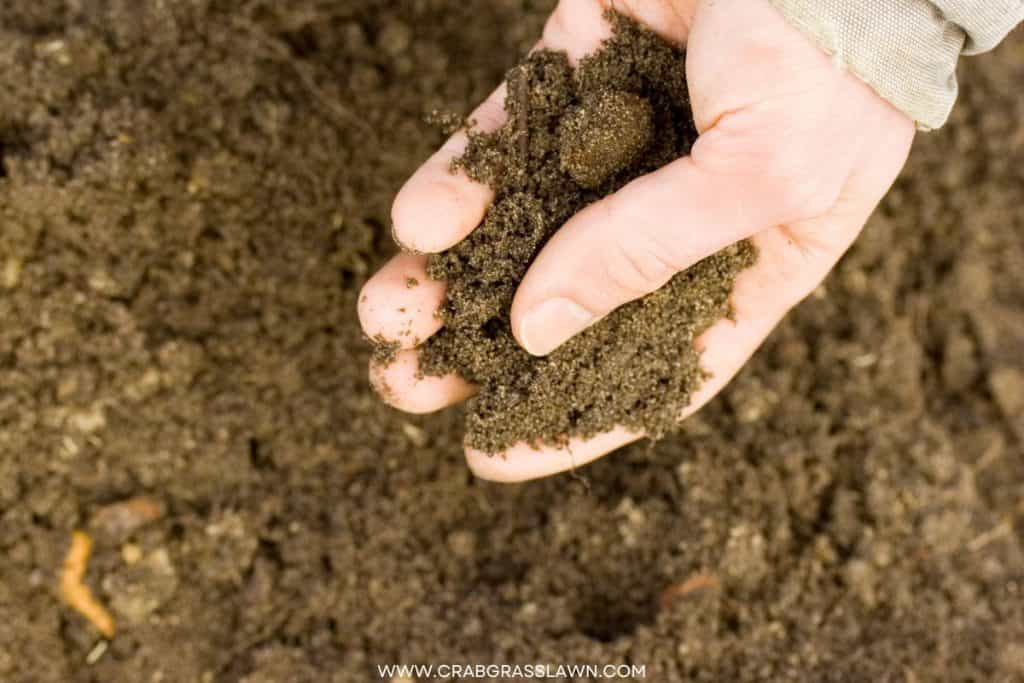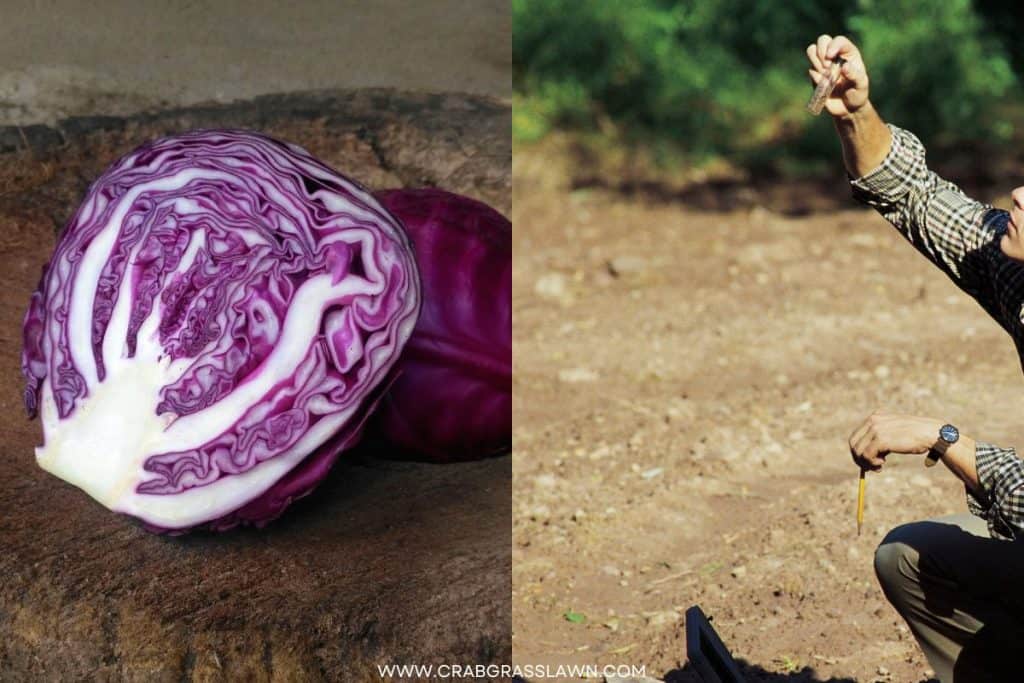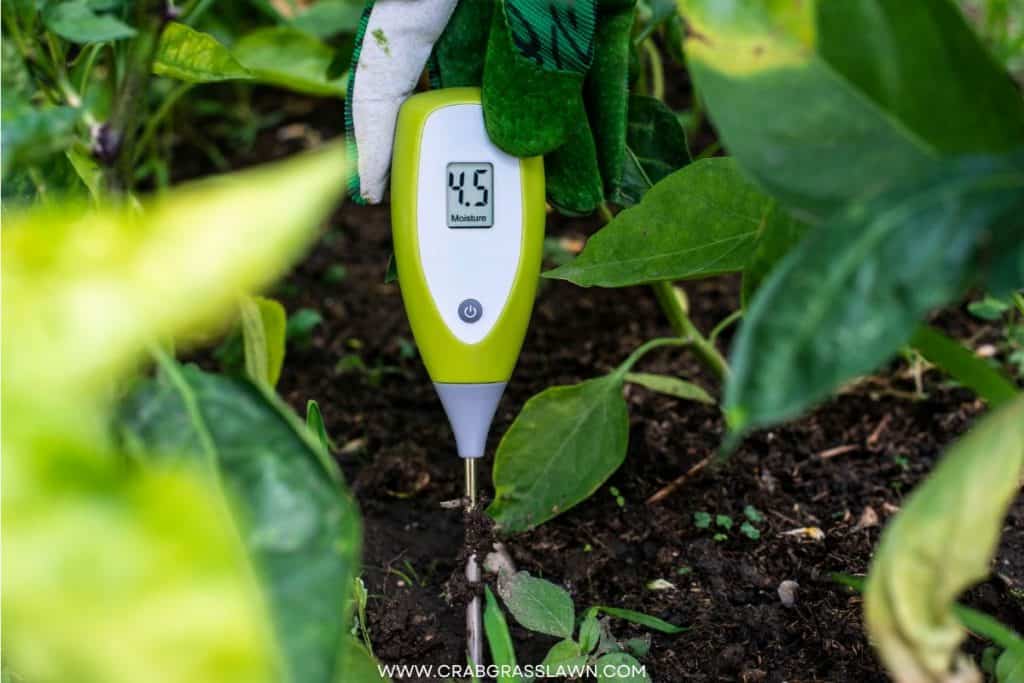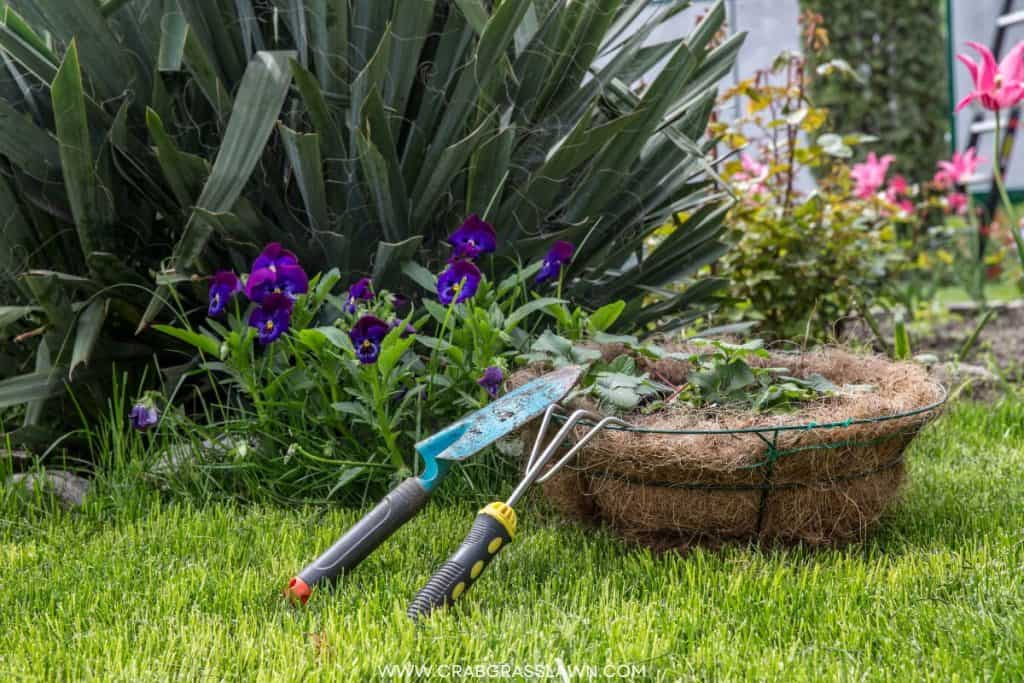The measure of the acidity or alkalinity of the soil is represented by soil pH. The pH scale can range between 0 – 14.0, with above 7.0 being alkaline, below 7.0 being acidic, and 7.0 as neutral according to South Dakota University.
I’ve tried several ways to test my soil pH but the 5 effective methods are:
- With vinegar and baking soda
- Red cabbage
- Soil test probe
- Soil test strips
- Send soil samples to the lab
I’ll explain what soil pH is, what it does, how to check soil pH, and most importantly why to monitor soil pH.
Causes of Acidic Soil
Your ground has likely become more acidic from the last time you performed a soil test, but this is a norm in most places.
Myriad different reasons can cause soil to become acidic including:
- Rainwater washes away basic ions such as calcium, magnesium, sodium, etc.
- Formation of strong organic and inorganic acids like nitric acid and sulfuric acid
- Carbon dioxide from decomposing organic matter
- Oxidation from certain fertilizers

How Does Acidic Soil Affect Lawn?
Acidic soil in your lawn can be good for some types of grass, and bad for others. For example, centipede grass and zoysia grass prefer acidic soil with a pH as low as 5.0, whereas carpetgrass and St. Augustine grass thrive in alkaline soil with a pH as high as 8.0.
Soil pH affects the availability of plant nutrients. Determining which nutrients affect soil pH can get complicated, but whether your soil is alkaline or acidic, some nutrients will be caught up, and unavailable in your lawn. Learn about the importance of soil testing.
However, alkaline soil can pose a bigger problem of dispersion, which can result in compact, dense soil, and can cause poor aeration, water drainage, and root growth.
1. Yellow spots on your lawn
If your lush green lawn has become tainted with yellow spots, these yellow color patches could be caused by several different factors such as dryness, disease, nutrient deficiencies, or excess nitrogen.
Nitrogen is an important nutrient for a healthy lawn, but too much nitrogen can cause chemical burns to the grassroots and alter the pH level in the soil, leading to yellow patches in your lawn.
2. Wilting grass blades
Wilting is usually an indication of insect or disease problems, but can also be due to high pH levels in the soil, which hinders your turf’s ability to absorb minerals and nutrients and minerals that are essential for healthy growth.
3. Stunted growth
Stunted grass growth is caused when your lawn cannot absorb water and nutrients from the soil. Acidic soils limit the availability of some essential nutrients and increase the availability of toxic elements such as aluminum and manganese, which is a serious factor limiting productivity in acidic soil.
Acidic vs. Alkaline Soil
Often dubbed as sweet soil, alkaline soil contains excessive amounts of calcium, sodium and magnesium, which makes it less soluble, and affects its ability to absorb nutrients.
Contrarily, acidic soil is caused when heavy waters wash away calcium and magnesium from the base of the soil, making this “sour” soil more toxic, and increasing its chances of harboring an excess of certain elements such as nitric acid, sulphuric acid or carbon dioxide, which can shock and kill grass.
| Acidic Soil | Alkaline Soil |
| 0-6 on the pH scale | 8-14 on the pH scale |
| Deficient in calcium and magnesium | Contains excessive sodium, calcium, and magnesium |
| Contains excessive amounts of carbon dioxide, nitric acid, and sulfuric acid | Has trouble absorbing nutrients |
| Common in moisture-rich climates | Common in arid climates with little rainfall |
Pro tip: You want to achieve neutral soil, one that ideally has a pH level of 7 for a thriving, balanced lawn.
So which one is right for your lawn – acidic or alkaline soil? Turfs grow best in soil that is slightly acidic to neutral (between 6.2 and 7.0 on the pH scale), but some types of grass can also do well at lower levels.
If your soil is too alkaline and compacted, that is a pH above 7.2, the roots won’t be able to absorb air, water, and nutrients, which leads to unhealthy grass and plant growth.
It’s also worth mentioning that weeds thrive in soil pH readings between 7.0 and 9.5, which is another reason to keep your soil pH level in check.

When Should I Test for pH?
For new lawns, it is recommended that gardeners check for soil pH, and if necessary, corrected with lime, compost, or other methods before laying the new lawn.
If you have an established lawn that isn’t performing well, its pH level may be off, for which testing is recommended to determine the cause of the issue and the best way to correct it.
5 Ways to Check Soil pH Level?
1. Vinegar and Baking Soda Method
If you don’t have a soil test kit, you can use baking soda and white vinegar to test the acidic conditions of your soil.
- Start by gathering a cup of soil from different areas of your lawn, and place them in two separate containers.
- Add one and a half cups vinegar to a container, and if the soil fizzes, it is alkaline with a pH level between 7 and 8.
- If it doesn’t fizz, add baking soda and distilled water to the soil in the other container, and if it fizzes, your soil is likely acidic with a pH level between 5 and 6.
- If there are no effects of vinegar, that is fizzing in any of the two containers, your soil is just fine.
2. Red Cabbage Soil pH Test
Who would’ve thought you could use red cabbage to test the pH of your soil, but you can, and adding to this it provides near-accurate results. However, you can’t use white cabbage to test soil pH.
Red cabbage contains anthocyanin, a chemical compound that:
- turns yellowish green when the pH of the soil is pH > 7.0
- reddish pink when the pH of your soil is acidic (pH < 7)
Apart from testing the pH level of your soil, you can also use red cabbage to test the water hardiness in your home.

To perform a red cabbage soil pH test:
- You first have to make a cabbage water solution by cutting up 4-6 red cabbage leaves and simmering them in 2 cups of distilled water in a saucepan for roughly 10 minutes.
- Next, remove the saucepan from the heat, and allow it to sit for approximately 30 minutes. The liquid will be purple/blue, and in this state will have a neutral pH of 7.
- Strain the liquid and set it aside.
- You only need 2 teaspoons of garden soil for this test, so go ahead and add the 2 scoops of soil to a clean plastic container along with a few inches of cabbage water, stir well, and wait for half an hour.
If the color of the water turns reddish-pink, your soil is acidic, but your soil is alkaline if the color turns blue/yellow-green.
3. Soil Test Probe
The easiest way of testing the acidic and alkaline conditions is with a soil pH test. Another good thing about a soil pH test kit is that you can buy it at your nearest home center, nursery, or online.
I’ve used both the Luster Leaf soil test kit and the SONKIR soil pH meter, and have received accurate results. The SONKIR soil test kit offers a bit more functionality than the Luster kit, in that it can test the soil moisture, pH level, and sunlight level of your plants in garden beds.
| Preview | Product | Rating | |
|---|---|---|---|

|
Luster Leaf 1818 Rapitest 4-in1 Soil pH/Moisture/Fertility/Light... | 1,185 Reviews | Check Latest Price |

|
SONKIR Soil pH Meter, MS02 3-in-1 Soil Moisture/Light/pH Tester... | 41,756 Reviews | Check Latest Price |
Affiliate links and images pulled from the Amazon Product Advertising API on: 2024-04-27
How to Use a Soil Test Kit?
Using a soil test kit varies across manufacturers, but the process is generally the same.
- Start by digging a hole approximately two to four inches deep into the ground.
- Move any dirt, debris, stones, etc. to the side, and fill the hole with distilled water (important), which is water that’s neither alkaline nor acidic, and is readily available at your nearest grocery store or pharmacy.
- Insert the test probe of the soil test kit into the muddy pool in the hole you just created. Wait about a minute for the test kit to render a reading.
Reading Analysis:
- Lower than 7 pH = acidic soil
- Higher than 7 pH = alkaline soil
- Exactly 7 pH = neutral soil

4. Soil Test Strips
Both soil test probes and soil test strips provide a near-accurate soil pH reading, but the latter requires a little more work. The SaySummer soil pH test strips render a 0 – 14 testing range and are easy to use.
- Use a hand shovel to obtain a soil sample by digging four to six inches below the surface of your lawn, and around trees.
- Remove the sticks, stones, and other debris from the soil sample, and place one to three teaspoons in a clean glass.
- Fill the glass with distilled water until you cover the soil sample, stir well, and let the mixture rest for 30 minutes.
- Drain the sample by pouring it through a coffee filter and into another clean glass, and dip the pH strip into the clean liquid.
- Refer to the color chart on the manufacturer’s packaging to determine the pH of your soil. Repeat the process with several different soil samples from different parts of your lawn to gauge the average pH.
| Preview | Product | Rating | |
|---|---|---|---|

|
SaySummer Soil pH Test Strips 100 PCS, 0-14 Full Range Soil... | 135 Reviews | Check Latest Price |
Affiliate links and images pulled from the Amazon Product Advertising API on: 2024-04-27

5. Send Soil Sample to a Lab
Even though soil test strips, soil probes, and the baking and vinegar method will give you a great idea of the pH level of your soil, getting your soil tested at a lab will provide you with detailed insights about your soil, and help you determine the missing nutrients and whether you need to add an acidic fertilizer, sulfur fertilizers or lime such as dolomite lime and fast-acting lime.
The lab process of analyzing soil samples isn’t as simple as dipping a probe or a strip into the pile but involves drying the soil sample to reduce its size, measuring the soil’s lime requirements, and creating a soil analysis report.
How to Raise Soil pH?
If your soil is acidic, the good news is that there are several ways of raising its pH level. Low nutrient availability can be detrimental to grass growth, so it’s best to provide the right availability of nutrients for your soil.

Add Garden Sulfur
Even though sulfur does take some time to increase your soil pH, it is in many ways the best option for your acid-loving plants and grass.
When applied properly the year before you intend to plant, sulfur lasts for years in your soil, but just like all other amendments, you need to have a soil test done to determine how much sulfur you need to apply to achieve your desired pH.
Add Peat Moss
Sphagnum moss is a great option for amending soil pH, and also adding organic material to your soil. Simply spread four to six inches of sphagnum peat moss on your topsoil, and till it to a depth of six inches. Sphagnum peat moss improves soil condition and is a good choice for sandy soil as well as clay soil.
- This lush carpet-like moss can hold moisture up to 20 times its dry weight!
- Great for live plants and incredibly long-lasting. After other substrates have decomposed, this moss remains usable and can be washed and reused several times.
- Harvested using sustainable methods to ensure that it will be around for future generations!
Affiliate links and images pulled from the Amazon Product Advertising API on: 2024-04-27
How to Lower Soil pH?
Just like raising pH, there are myriad ways to correct alkaline soil including adding well-decomposed compost, manure or organic soil amendments like alfalfa meal.
- Alfalfa meal
- Great source of trace elements for fertilizing and soil conditions
- Great for roses and earthworms alike
Affiliate links and images pulled from the Amazon Product Advertising API on: 2024-04-27
If you guys prefer a visual description on how to measure the PH in your soil, you can watch the video below:
Final Thoughts
The ideal soil pH for most turfgrasses is roughly 6.5, which is considered slightly acidic. There are several ways to determine if your soil is acidic including with vinegar, soil test strips or sending soil samples to the lab. Once you determine your soil pH, you can make the necessary amendments to ensure your plants and grass thrive
Hi, Alex Kuritz here. Growing up I remember that my family had one of the best lawns in the neighborhood. Richly green and lush. I did a lot as I grew up in terms of caring and tending for not only my family’s lawn but also my neighbors. I can say I have years of experience, and I am here to share it with you.




